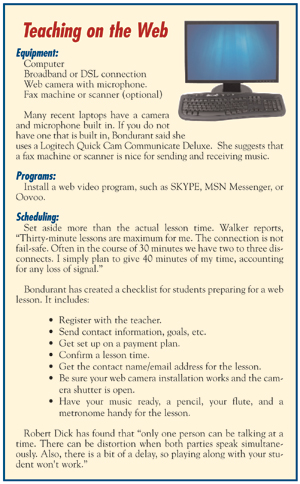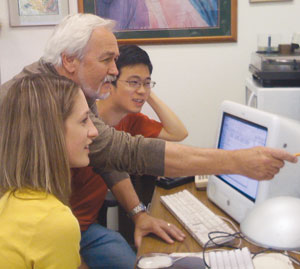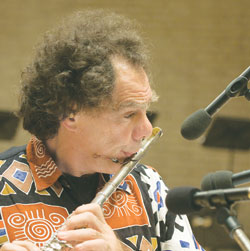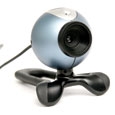The information age and all its technology have not escaped the notice of flutists. The use of webcams has introduced students and teachers to a whole new world in which students can sit in their living rooms in one country and learn from the professor in another.

For the past four years flute teacher Kathleen Bondurant has taught flute students in countries around the world, including the Bahamas, Korea, and Israel, by webcam. She began using the technology after getting an assignment in the Bahamas.
“In 2005 I was asked to come to the College of the Bahamas for two years to help them with their undergraduate music program. My students in Austin, Texas were devastated. With a webcam I was able to continue teaching them.”
 Bondurant finds that time, comfort, and scheduling are just a few of the benefits. “Webcam lessons are hugely convenient because you don’t lose any time in transportation. Students can receive lessons in the comfort of their own homes, and I can fill in my schedule.” She adds, “It is also easier to set up lessons at a moment’s notice for things like emergency auditions.”
Bondurant finds that time, comfort, and scheduling are just a few of the benefits. “Webcam lessons are hugely convenient because you don’t lose any time in transportation. Students can receive lessons in the comfort of their own homes, and I can fill in my schedule.” She adds, “It is also easier to set up lessons at a moment’s notice for things like emergency auditions.”
Drawbacks include a lack of physical contact, which places a greater emphasis on listening. “For me, webcam lessons are hugely draining because I have to listen so very closely to make up for what I can’t see, although Skype and other such programs have excellent sound quality.” Skype is a software application that uses the internet for voice and video communication. Similar programs include iChat, Gizmo Project, Google Talk, Jajah, and ooVoo.
She recommends that students take traditional lessons first; this is not a good method for teaching beginners. “When students have a year or more experience, they tend to know what to listen for and what they would like to accomplish during lessons. My youngest student (in Israel) is 11 years old, but his father usually sits in on the lessons, in the event further explanations are needed and to make sure everything is understood.”
Webcam lessons aren’t without technological woes. “The worst nightmare is having a technical glitch, such as the internet going out, the electricity failing, or having to tell a student, ‘I’m sorry, but the dog ate the cable connection.’”
Bondurant prepares for lessons by requesting that students provide a list of the repertoire they want to cover. After the lesson she makes notes about the student’s lesson and plans assignments for subsequent meetings.
 Nina Perlove also teaches via webcam. “It is extremely convenient for me,” she said. “I can drop my children off at school and then come home to teach students in Seattle, Wisconsin, and Israel. I call it my virtual world tour.”
Nina Perlove also teaches via webcam. “It is extremely convenient for me,” she said. “I can drop my children off at school and then come home to teach students in Seattle, Wisconsin, and Israel. I call it my virtual world tour.”
Perlove developed an interest in using the technology for teaching after putting videos on YouTube. “So many students emailed questions or wanted me to listen and comment on their videos.” She began by posting teaching videos on YouTube and developing a website. She has taught students in the U.S., Israel, and Ireland. She recommends that students be nine or older. “It helps if they already have enough foundation to know how to make a basic sound and play the basic fingerings.”
In addition to lessons via webcam, Perlove has helped a student determine which flute and headjoint to purchase. “I certainly thought that given the limitations of distance, microphones, and internet connections, I wouldn’t be able to hear differences between the instruments. I found it pretty amazing that I could hear that level of detail over Skype.”
Perlove’s work was featured on the Oprah Winfrey Show in an episode entitled “Where the Skype are you?” They used a 10-second clip of a video lesson, which is available at http://tinyurl.com/nhzal2. The student she was teaching lives in Israel.
There are some technical limitations that affect her teaching style. “The student hears my comments about a half second after I speak, which in normal conversation is barely noticeable,” she said. “However, the time delay hampers the ability to play along with the student. I have adapted my teaching in some ways to accommodate this slight time delay. I can’t actually clap or stomp or even sing along while a student plays (things I normally do in in-person teaching), so instead I try to use exaggerated facial expressions and hand gestures that the student can see easily on their screen. Also, because I can’t play along with a student in real time, I use an innovative teaching platform called Ashbury Music Hall (www.ashburymusichall.com), which allows me to record private videos easily that the student can play along with in his practice sessions. It allows me to continue a virtual interaction with them between scheduled lessons.
“I also believe that the teacher must transfer energy to the student. Even with a video camera and a 2,000-mile distance, I still work to convey the same energy and excitement as if we were in the same room.”
 James Walker has been teaching flute via webcam for one year. “I just loved the concept once it became available to a lot of people. It gives somebody in a faraway place the opportunity to have lessons with me.”
James Walker has been teaching flute via webcam for one year. “I just loved the concept once it became available to a lot of people. It gives somebody in a faraway place the opportunity to have lessons with me.”
While he doesn’t think the technology is perfect, it allows him to be more available. “I want to make it more and more part of my whole teaching life.
“One major advantage is that someone can actually see you, hear you, and play for you without having to buy a ticket to come to Los Angeles. Also, if a student wants to see if there’s any personal chemistry with a teacher, he can tell that through a webcam lesson.”
Walker believes students of all ages can use this technology for lessons. “It comes down to the student being comfortable seeing me on the screen and playing into a camera,” he said. “The sound qualities are not nearly as good as they are in person, but the kind of things I listen for I can hear via webcam.” Walker said he listens for vibrato problems and attends to fingering and other technical problems.
As for cost, Walker charges a little less for webcam lessons, and students pay through Paypal or check. Most of his students are in the U.S., but he has a student in Korea and interest from a European student.
 New York flutist Robert Dick has been teaching lessons via webcam since the fall of 2008. “The first lesson I gave was to a person in France. It just amazed me that I was at home and teaching someone in France.” He thinks the technology has helped both students and colleagues. “You can have access to information, ideas, and performances as never before, and students and colleagues have access to you.”
New York flutist Robert Dick has been teaching lessons via webcam since the fall of 2008. “The first lesson I gave was to a person in France. It just amazed me that I was at home and teaching someone in France.” He thinks the technology has helped both students and colleagues. “You can have access to information, ideas, and performances as never before, and students and colleagues have access to you.”
Dick charges $160 for lessons in person and $100 for webcam lessons. “It’s certainly not the same as being physically present. It’s very good but not the same, so I do charge less for webcam lessons.”
He uses Skype and finds that “the sound quality has been very usable, and I can see the player just fine. It’s workable, and I have a separate remote camera, which helps with things such as close-ups of the embouchure.”
Dick offered suggestions for those wanting to explore webcam teaching.
“Have enough light so that students can see what you’re doing in detail. Also, students should have enough light, so that you can see them as well. Make sure that you can hear them clearly.” For that purpose Dick uses a very good pair of headphones rather than the computer speakers.
“It’s all become so simple and easy you don’t need extensive technical skills at all. When I was a boy I would read science fiction stories and there would be pictures of people talking to each other on a screen. Now here we are, talking and playing on the screens. It is just amazing.”
 Thomas West began teaching via webcam during the past school year. “I work at a school for the performing and fine arts that is attached to Pennsylva-nia Leadership Charter School, a K-12 cyber school. Students in 5th through 12th grades audition to commute to the Center for Performing and Fine Arts for an entire school day twice a week and do their other coursework online.”
Thomas West began teaching via webcam during the past school year. “I work at a school for the performing and fine arts that is attached to Pennsylva-nia Leadership Charter School, a K-12 cyber school. Students in 5th through 12th grades audition to commute to the Center for Performing and Fine Arts for an entire school day twice a week and do their other coursework online.”
West saw the success that other teachers were having with web-based technologies to teach math, science, language arts, and history. “I knew it was possible to teach music lessons in the same manner.”
West also finds a financial benefit to web lessons. “There is practically no overhead to teaching lessons. An inexpensive web camera, a decent computer, and broadband internet access are all you need. Instead of spending time and gas travelling to students’ homes, I sit in the comfort of my own home and teach two students an hour at times that are convenient for us both.
“One of the things you can’t do via the web is play a duet with a student, but I work around that by incorporating work with Smart Music or by recording myself playing a duet part and emailing them an mp3.”
West finds webcam microphones to be a particular challenge. “Most webcam microphones have trouble with auto-adjusting their gain for instrumental playing. They automatically adjust their sensitivity as someone speaks, which makes it possible to hear the speaker without a headset.” To remedy this problem West works with other software and equipment. “There are low-gain lapel mics for students to clip onto their collar, behind a violin bridge, or on a trumpet bell.”
Prices for webcam lessons vary depending upon the teacher. After the purchase of equipment West charges the same for traditional and webcam lessons. His students typically pay via Paypal or credit card.
West believes that teachers must be experienced to make webcam lessons work. “The teacher must be able to work around the limitations of current technology, mostly in terms of sound level and latency issues. It takes an experienced teacher with a lot of knowledge of effective techniques to be able to work with students online.”
Students’ Perspectives
Ashley Jensen is a student of Nina Perlove. “I am such a computer tech savvy person; I think it’s a great way for students like me to have lessons. You’re not only limited to the local teacher. I can plan my lesson according to my schedule more easily, and it saves on travel expenses.”
Student Marinke Slump, who studies with West, says “For me, living in The Netherlands, webcam lessons are a great way to meet new teachers from the U.S. There are a lot of famous flutists, such as Nina Perlove and Ali Ryerson who live and work in the U.S. Webcam lessons take away the boundaries and enable me to take lessons from the pros!”
Alexander Eydelson, whose son, Adam, takes lessons from Perlove and Bondurant, said his son also likes the opportunity to study with teachers who would otherwise be unreachable. Eydelson and his son live in Israel, and Adam also studies with Anatoly Kogan in Israel.
After observing the lessons, Eydelson believes the difference in taking lessons in person versus the webcam is in the technical challenges. “It is a very similar experience, except for technical limitations. The internet connection isn’t always perfect, which sometimes causes dropped calls and other technical issues.”
Bondurant: www.fluteconnection.com
Perlove: www.realfluteproject.com
Walker: www.jimwalkerflute.com
Dick: www.robertdick.net






